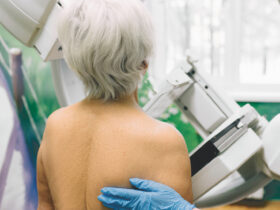By Dennis O. Sagini, MD
 In my years of practice, I’ve witnessed a significant increase in patients presenting with a sharp, stabbing pain at the base of their thumb that radiates up their forearm. This condition, known as de Quervain’s tendinitis, has become increasingly common in our smartphone-dominated society, earning it the nickname “mother’s thumb” or “texting thumb.”
In my years of practice, I’ve witnessed a significant increase in patients presenting with a sharp, stabbing pain at the base of their thumb that radiates up their forearm. This condition, known as de Quervain’s tendinitis, has become increasingly common in our smartphone-dominated society, earning it the nickname “mother’s thumb” or “texting thumb.”
What Is De Quervain’s Tendinitis?
De Quervain’s tendinitis is an inflammatory condition affecting the tendons on the thumb side of the wrist. Specifically, it involves the abductor pollicis longus and extensor pollicis brevis tendons, which control thumb movement and pass through a narrow tunnel called the first dorsal compartment. When these tendons become swollen or irritated, they struggle to glide smoothly through this tight space, causing pain and restricting movement.
The Modern Triggers
While this condition was first described by Swiss surgeon Fritz de Quervain in 1895, today’s triggers are distinctly contemporary. The repetitive thumb movements required for texting, gaming, and smartphone use have made this condition remarkably prevalent among younger demographics. New mothers are particularly susceptible due to hormonal changes during pregnancy and the repetitive lifting motions required when caring for infants.
Other common causes include repetitive wrist movements in occupations such as carpentry, gardening, or assembly line work. Athletes involved in racquet sports or rowing may also develop this condition due to repetitive gripping motions.
Recognizing the Symptoms
Patients typically describe a gradual onset of pain and swelling near the base of the thumb. The pain often worsens with thumb and wrist movement, particularly when making a fist, grasping objects, or turning the wrist. Many report difficulty performing simple tasks like opening jars, turning door handles, or even holding their morning coffee cup.
The hallmark diagnostic test is Finkelstein’s test, where patients make a fist with their thumb tucked inside their fingers, then bend their wrist toward their little finger. A positive test reproduces the characteristic sharp pain along the thumb side of the wrist.
Treatment Approaches
Early intervention is crucial for optimal outcomes. Initial treatment focuses on rest and activity modification. I often recommend patients avoid repetitive thumb movements and consider ergonomic adjustments to their workspace or device usage patterns.
Conservative treatment includes ice application during acute phases, followed by gentle stretching exercises. Thumb spica splinting can provide significant relief by immobilizing the affected tendons. Anti-inflammatory medications may help reduce swelling and pain.
For persistent cases, corticosteroid injections into the tendon sheath can provide dramatic relief. However, when conservative measures fail after several months, surgical release of the first dorsal compartment may be necessary.
Prevention and Prognosis
Prevention centers on ergonomic awareness and activity modification. Taking regular breaks from repetitive activities, maintaining neutral wrist positions, and strengthening exercises can significantly reduce risk.
With proper treatment, most patients experience complete resolution of symptoms. The key is early recognition and appropriate intervention, preventing this manageable condition from becoming a chronic, debilitating problem that affects daily quality of life.
If you’re experiencing thumb or wrist pain that may be related to de Quervain’s tendinitis, don’t let it progress to a more serious condition. Early diagnosis and treatment are essential for the best outcomes. Contact our office at 239-302-3216 to schedule a consultation and take the first step toward pain-free movement and improved quality of life.
Dennis O. Sagini, MD
TDr. Sagini is an orthopedic surgeon with specialization in hand and upper extremity surgery. He specializes in arthritis of the hand, nerve compression, muscle and tendon injury, fracture care, and upper extremity dysfunction.
He completed his Bachelors of Science in Microbiology from the University of Oklahoma in Norman, Oklahoma in 1998 and his Doctor of Medicine at Temple University in Philadelphia, PA in 2002. It was during medical school training that Dr. Sagini developed an interest in orthopaedic surgery. His residency in orthopaedic surgery was completed at Howard University Hospital, Washington, DC. Dr. Sagini completed his fellowship training in Hand and Upper Extremity surgery at the University of Pittsburgh Medical Center in Pittsburgh, PA.
Dr. Sagini is a member of the American Academy of Orthopaedic Surgeons, the American Medical Association, the Florida Medical Association, and the American Society for Surgery of the Hand.
Dr. Sagini is active in research and community service and has a passion for overseas medical mission work. He also enjoys running, traveling, listening to music, cooking, tennis, and spending time with his family and friends.
239-302-3216 | saginimd.com
13691 Metro Pkwy, Suite 400
Fort Myers, FL 33912








